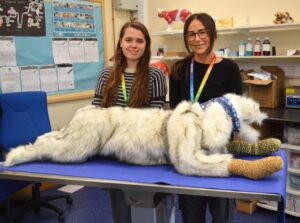Growth Hormone Secretion: Ipamorelin Research

Ipamorelin is a pentapeptide since it has five amino acids. Its amino acid sequence of Aib-His-D-2-Nal-D-Phe-Lys-NH2 classifies it as a growth hormone-releasing peptide (GHRP). C38H49N9O5 is its chemical formula, and its weight as a molecule is 711.9 grams. Studies suggest that the structural similarities between this peptide and Hexarelin, GHRP-6, and GHRP-2 may make them useful in potentially stimulating animal growth hormone production. However, the essential GHRP-1 dipeptide Ala-Trp is absent.
Ipamorelin seems to function as a smooth replacement for GHRP-6 and GHRP-2 based on its purported impact on research models and the negative effects associated with other growth hormone-releasing peptides. Findings imply there was no data that the peptide caused substantially different amounts of cortisol, prolactin, or adrenocorticotropic hormone (ACTH) release compared to those seen in response to GHRH stimulation.
The peptide’s purported propensity to impact just the growth hormone axis alone, in contrast to other peptides like GHRP-6 and Sermorelin, may make it useful for studying the isolated effects of growth hormone secretagogue agonists, which may explain the peptide’s initially positive hypotheses on efficacy.
Ipamorelin Peptide Research
Research suggests that the Ipamorelin peptide seems to trigger its activation when bound to the ghrelin receptor. The growth hormone secretagogue receptor (GHS-R) may regulate energy and weight. The GHS-R is most prevalent in the brain but has also been detected in the heart, skeletal, and liver muscles. Facilitating pituitary growth hormone secretion is the primary function of the ghrelin receptor. Unlike other ghrelin receptor agonists, Ipamorelin peptide has been hypothesized to stimulate growth hormone release primarily and may have little impact on other hormones.
Studies have suggested that the half-life of Ipamorelin peptide is just 2 hours, making it a useful tool for comparing the effects of growth hormone stimulation to those of other physiological processes, including metabolism, stress response, etc. Findings imply that this peptide’s time to have an effect might be from a few hours to a few months, depending on the variable being examined.
Minutes after the presentation, Ipamorelin was suggested to influence blood sugar and insulin concentrations. However, it may take months for data to emerge from studies examining how Ipamorelin may impact synaptic density, bone density, or muscle size. Scientists purport that although it may seem that Ipamorelin begins working instantly, depending on the rate of the specific route, the biochemical changes may not become evident for quite some time. The process of neurogenesis, for instance, takes a long time. It has also been speculated that despite the rapid impact of Ipamorelin on dendritic development, the whole influence won’t be apparent until the growth’s slow process is complete.
Researchers need to consider the pace of change that a given organism can maintain to make an educated guess as to how long it will be before they learn whether or not the experiment was successful. Growth Hormone is generated by the pituitary gland, which also plays a regulatory role in the endocrine system and provides general oversight. Hormones are secreted and distributed throughout the body via the endocrine system.
Ipamorelin Peptide and Sleep
Some research suggests that Ipamorelin and other growth hormone enhancers may improve sleep, drawing from its supposed impact on cognition. Sleep has a significant role in the aging of tissues and is a crucial mediator in establishing recall between long and short term memory.
Ipamorelin Peptide and Cognition
The ghrelin receptor has been linked to cognitive functions such as memory and learning. The activation of GHS-R was speculated to increase the dendritic spine density and long-term facilitation of these activities. Dendritic spine density measures the extent to which neurons are connected, whereas long-term facilitation strengthens connections between brain cells. Ipamorelin has been proposed because of its potential to boost cognitive performance on both fronts by stimulating the ghrelin receptor.
Ipamorelin Peptide and Bone Tissue
Osteoclast activity increases with age, and is considered to decrease bone density. In addition to their function in bone resorption, osteoclasts contribute to bone remodelling in response to sustained mechanical stress or injury. When there are more of these cells than new bone cells are being created, bone density decreases. Initiating degradation and removal at exactly the proper speed to ensure good bone strength and function is essential, and early research purports that Ipamorelin peptide may help restore this balance.
Ipamorelin Peptide and Aging
Scientists have studied the potential anti-aging impact of Ipamorelin. Muscle atrophy, neurological decline, and bone density loss are just a few of the aging-related physiological changes. Several metabolic pathways degrade when the capacity to produce certain hormones declines. Studies in Ipamorelin have suggested a possible correlation between peptide supplementation and hormone production maintenance.
References
[i] Holst B, Brandt E, Bach A, Heding A, Schwartz TW. Nonpeptide and peptide growth hormone secretagogues act both as ghrelin receptor agonist and as positive or negative allosteric modulators of ghrelin signaling. Mol Endocrinol. 2005 Sep;19(9):2400-11. doi: 10.1210/me.2005-0059. Epub 2005 May 19. PMID: 15905359.
[ii] Raun K, Hansen BS, Johansen NL, Thøgersen H, Madsen K, Ankersen M, Andersen PH. Ipamorelin, the first selective growth hormone secretagogue. Eur J Endocrinol. 1998 Nov;139(5):552-61. doi: 10.1530/eje.0.1390552. PMID: 9849822.
[iii] Johansen PB, Nowak J, Skjaerbaek C, Flyvbjerg A, Andreassen TT, Wilken M, Orskov H. Ipamorelin, a new growth-hormone-releasing peptide, induces longitudinal bone growth in rats. Growth Horm IGF Res. 1999 Apr;9(2):106-13. doi: 10.1054/ghir.1999.9998. PMID: 10373343.
[iv] Greenwood-Van Meerveld B, Tyler K, Mohammadi E, Pietra C. Efficacy of ipamorelin, a ghrelin mimetic, on gastric dysmotility in a rodent model of postoperative ileus. J Exp Pharmacol. 2012 Oct 19;4:149-55. doi: 10.2147/JEP.S35396. PMID: 27186127; PMCID: PMC4863553.
[v] Jiménez-Reina L, Cañete R, de la Torre MJ, Bernal G. Influence of chronic treatment with the growth hormone secretagogue Ipamorelin, in young female rats: somatotroph response in vitro. Histol Histopathol. 2002;17(3):707-14. doi: 10.14670/HH-17.707. PMID: 12168778.



